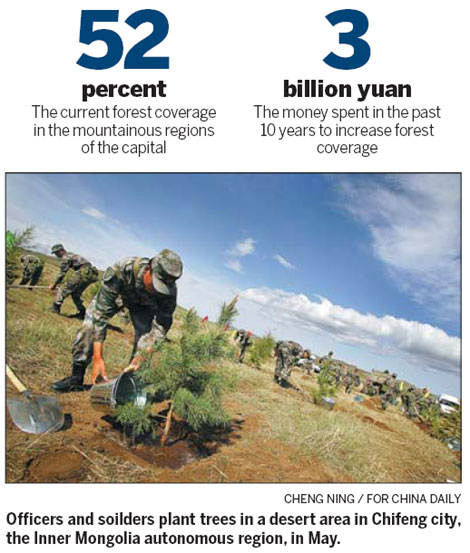Sand project restores environment
Updated: 2011-08-04 08:07
By Cang Wei (China Daily)
|
|||||||||||
BEIJING - Thanks to a sand treatment project, people now can expect to see pheasants and hedgehogs in Beijing's mountainous regions, where 10 years ago there were just bare rocks and wasteland.

"You can also hear various birds singing in the region's forests, although you may not be able to see them," said Tong Yonghong, a senior official from the capital's publicity center.
"But it will be hard for you to find your way if you get lost in the forests," Tong said with a smile.
To control sandstorms, in 2001 China proposed the Beijing-Tianjin sand treatment project, which covers five municipalities and provinces, including Shanxi, Hebei and the Inner Mongolia autonomous region.
As part of the project in a city that has more than 47,000 hectares of desertified land, Beijing invested more than 3 billion yuan ($470 million) in the past 10 years to increase forest coverage, said Hu Jun, of the Beijing Municipal Bureau of Landscape and Forestry.
Gan Jing, deputy chief of the general office of the Capital forestation commission, said that 367,200 hectares of wasteland and mountainous areas in the capital had been converted into forest by 2010, and 44,000 hectares of grass had been planted. At present, forest coverage in the mountainous region of the capital stands at about 52 percent.
"The artificial forestation in Beijing's mountainous areas has been fruitful," said Hu. "In the spring of 2000, Beijing was shrouded by 14 sandstorms, but now it only has about two dusty days, which are classified as less polluted than sandstorm days."
As well, the capital's sand-prone areas are not suffering as badly now, Hu said.
"The areas that used to be covered by mobile sand and semi-mobile sand have all been covered by fixed sand now, which means that wind can no longer blow it away so easily."
As well as increasing vegetation and reducing soil erosion in the mountainous areas, the project has also improved economic development in the spacious mountainous areas.
According to the landscape and forestry bureau, the income of the regions in Beijing that are involved in the project soared from 20.7 billion yuan in 2000 to 82.8 billion yuan in 2009.